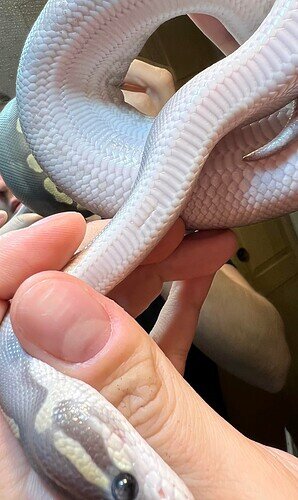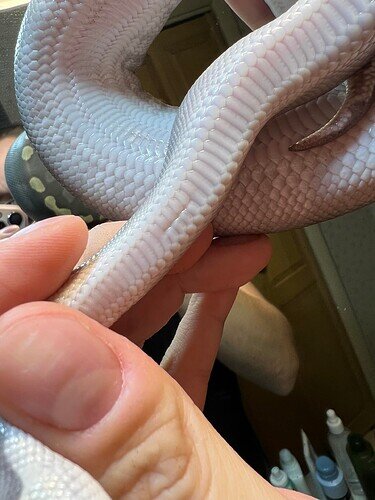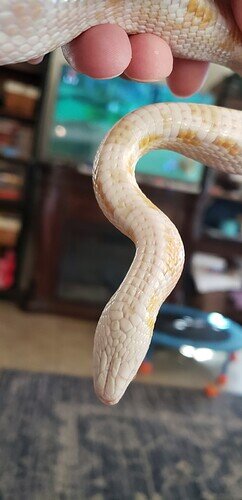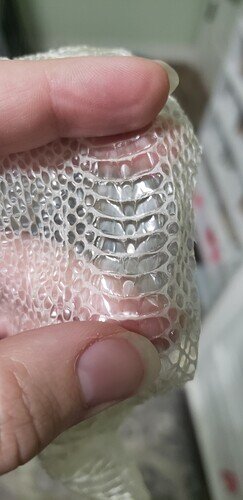I can’t say for sure if this is a birth defect or injury since Ive had the snake for a month now and just noticed this on her body last night. She has a bowl hide and water dish in her tub, nothing feels sharp. If it is a birth defect id worry about the ethics of breeding her.
It appears to be a slit in the scales on her upper neck.
3 Likes
Hi and welcome to the community.
I haven’t seen that personally with many decades of breeding unless it was an injury, but that doesn’t mean much.
If its a birth defect, (which I am not sure of) it doesn’t look like it would affect health though and so not offspring. But only time would tell.
Hopefully others ,may be able to help. I just wanted to welcome you really. 
1 Like
I have a corn snake with something similar. It doesn’t seem to affect her in any way and I haven’t had her since birth, so I don’t know if she’s always had it. She doesn’t have anything abnormally sharp in her enclosure. And it doesn’t go away after a shed. I’m not particularly worried about it, but I do wonder what it is.
This girl actually just shed, so I was curious to see if those indent things were present on her shed as well. Yup!
3 Likes
It’s definitely worrisome since I paid $1000 for her, if it’s a birth defect id worry about it being passable to offspring since I intended to breed her and if it’s a random healing wound then it just a matter of it healing.
1 Like
What you’ve got there is a snake with some cleft scutes. Yes, it is a birth defect, but it’s not one that causes any issue asides a small visual blip. As far as I am aware, in some species it’s a sign of inbreeding (not sure on BPs) but in others it’s just a random developmental fluke. You’d have to ask someone who has breeding experience for sure whether or not this is heritable, but as it’s a visual defect and not a structural one, I wouldn’t worry too much. Kinda like a birth mark.
6 Likes
To others reading this, regarding the ethics… Would you breed this snake since it was bought with intentions to breed? Would you try to return this snake despite being a month later after delivery?
1 Like
I would breed it, to me it’s not really a defect, at least not one that can cause any issues with the babies in my opinion. I mean I know it’s genetic, but scaleless head snakes are missing scales and have a split in their belly scales before their cloaca. They don’t seam to have any problems, and they most definitely do pass it on to their offspring, I bet this snake will not. I wouldn’t worry about it, just gives your nice looking snake a unique feature
6 Likes
It looks more like a small scar than a defect to me. I’d let her go through a few sheds to see if it fades, but even if it doesn’t I still wouldn’t worry much about it as long as it’s not causing her any health issues.
5 Likes
Considering it’s just a small patch and there appears to be no structural issue underneath, I don’t see why breeding would be an issue. Scales form rather late in development, so it’s quite possible it was an incubation issue. This particular book suggests the same. I’d consider something like this more of a birth mark than an actual “defect”. As for returning the snake, I feel like finding a visual defect after a month is far too long to do so, regardless. When you purchase a new animal, it’s up to you to do a proper visual inspection when it arrives so any issues are found immediately.
8 Likes
My thoughts are that unless it effects the quality of life I don’t see it as a defect. Like others have said some snakes have different “markings”. Only time will tell, raising it up will tell if it has any difficulties, and if all is good then breeding would be the next test if its genetic. Breeders before us found out what to and what not to breed by breeding. The ethics of it I think its only irresponsible to breed known defects like spider X spider, or any snake with a wobble or kink. something we know brings down the quality of life. Like I said time will tell on what you should do, but it doesnt look like it should effect its quality of life.
A side question…
Can you share a top photo? Curious what it looks like.
4 Likes
I hope youre right. I noticed when she was eating and her neck stretched with food going down those scales are not connected right there.
2 Likes
Hopefully it’s nothing more, thanks for the book link. It might be up to me to check when I get a snake but a breeder also should be responsible to thoroughly check over their snakes for potential issues before sending out, especially at this price point. Not all buyers are going to be experts(or they’re new/inexperienced) on knowing what to look for, im certainly not.
2 Likes
Id only see it as a defect if it passed on to the offspring. According to my studies one key rule of inbreeding(which goes on A LOT in our hobby) is to not breed animals with defects. Im not making any claims though that this is from inbreeding OR incubation. She will at least be paired with unrelated snakes.
3 Likes
Lets say for a moment that it is genetic, and that it does not cause the snake any problems what so ever. What would be the difference between say yours and a scaleless head. or would a scaleless head be a defect. I have read many articles where people debate that any variation other then a normal is a defect in the genes that cause it to be altered. I’m not saying I completely agree with that but some do. Look at Albinos, not 100% sure if its the same as I’m not an expert but for humans this website states “The cause of albinism is a defect in one of several genes that produce or distribute melanin ( Albinism: Causes, Types, Pictures, Symptoms, and More (healthline.com)”. If it is the same then it is a defect and people breed them all the time, and what would be the difference between Albino and say another recessive like Axanthic which prevents them from producing yellow pigmentation. I know some people are highly against breeding only certain animals with Albinism such as tortoises because they require UV which is understandable.
Please don’t look at this as an attack but a more in depth discussion that is definitely up for debate. I am in no way an expert and can only go off of what my research has told me. This is why when people start saying defect my mind automatically goes to how their quality of life is, because from what I have read a lot of the morphs are defects and not all defects effect their quality of life.
Also if I am wrong about any of this someone please correct me or share you thoughts and/or opinions on it. Everything I know Is from reading about it or someone with more experience telling me.
Sorry if everything seems all over the place I was trying to put all my thoughts down at the same time in an organized manner 
5 Likes
Every ones has to draw the line some where and I draw the line at physical abnormalities. I would not bred or own scaleless head. I dont view any of this as attacks, this discussion is great. I think my biggest reason Im stuck on this is that Idk if it’s genetically linked or caused by inbreeding or caused by incubation error or some thing random. I take no specific stand on the flaw of my snake. I just want to hear from more experienced honest breeders.
If some one is paying thousands of dollars for snake are they going to knowingly pick the one with minor defect or the one that is flawless physically.
These quotes are from an old book on breeding Budgies but it still seems to be relevant and make sense when it comes to breeding animals.
“this is a definite rule to which all inbreeders must adhere to in regards to all major weaknesses as far as humanly possible and as in regards to all minor faults as well in a word it is of vital importance that one should never inbreed with two birds each having the same fault nor with two specimens if one of them possesses a weakness”
“do not overlook the fact that a serious failing in an ancestor may not show itself for a number of generations and that applies to deleter’s recessive alleles when an old fault reoccurs unexpectedly it must receive immediate attention with a view to its elimination otherwise inbreeding will consolidate it”
-The cult of the Budgerigar
3 Likes
My Egyptian egg eating snake (Dasypeltis bazi) has the exact same sort of mark right above her cloaca. I’ve heard that some snakes have that mark because it’s a scar from where the umbilical cord was attached (making it just a belly button), but seeing the same mark on the neck of your snake is odd, and makes me wonder if my gal actually has a minor birth defect.
She does have other minor details that appear to be birth defects (very odd scalation on her chin), so I wouldn’t be surprised. But, it’d be interesting to know.
4 Likes
My friend’s corn snake actually has something similar on her belly (sorry, don’t have any pictures). This corn snake is 15+ years old and it’s never caused any issues. She was a breeder before my friend got her, though my friend hasn’t ever bred her and we’ve never seen any of her offspring, so I couldn’t tell you if it was genetic and passed on to future generations, but since it never caused problems for my friend’s corn, I doubt it had any ill effects on her offspring even if it was hereditary. It seems more akin to a birth mark rather than a true genetic “defect” (to me, that word implies some sort of negative impact on health or quality of life).
Obviously the choice of whether or not to breed her is up to you, but I don’t think it would be unethical to do so. I do think it’s much too late to request a return/refund from the breeder. While you’re correct that breeders have a responsibility to sell healthy animals and disclose any potential problems, by your own account, this snake is healthy and has no functional issues. And if it took you this long to notice this minor cosmetic blemish, I think it’s likely that the breeder simply didn’t see it before shipping her to you.
She looks like a beautiful snake, I hope you’re able to enjoy her for many years to come, and that she gives you some pretty babies if you decide to go ahead with breeding her. 
5 Likes





